Consumer Psychology Report: Store Layout and Customer Decisions
VerifiedAdded on 2020/06/06
|12
|4112
|269
Report
AI Summary
This report delves into the field of consumer psychology, exploring how customers make purchasing decisions. It examines the impact of customer service, highlighting characteristics like personalization, professionalism, and promptness, along with rules for effective service delivery. The report also discusses in-house promotion versus outsourcing, outlining their respective benefits and risks. Furthermore, it analyzes various promotional techniques used by companies, including advertising and digital media, and how they influence consumer behavior. The report then focuses on store layout, emphasizing its role in shaping consumer behavior and store image, and provides a step-by-step guide to planning an effective store layout, considering factors like customer traffic flow and product placement. The report concludes by summarizing the main points, offering a comprehensive overview of consumer psychology and its practical implications.
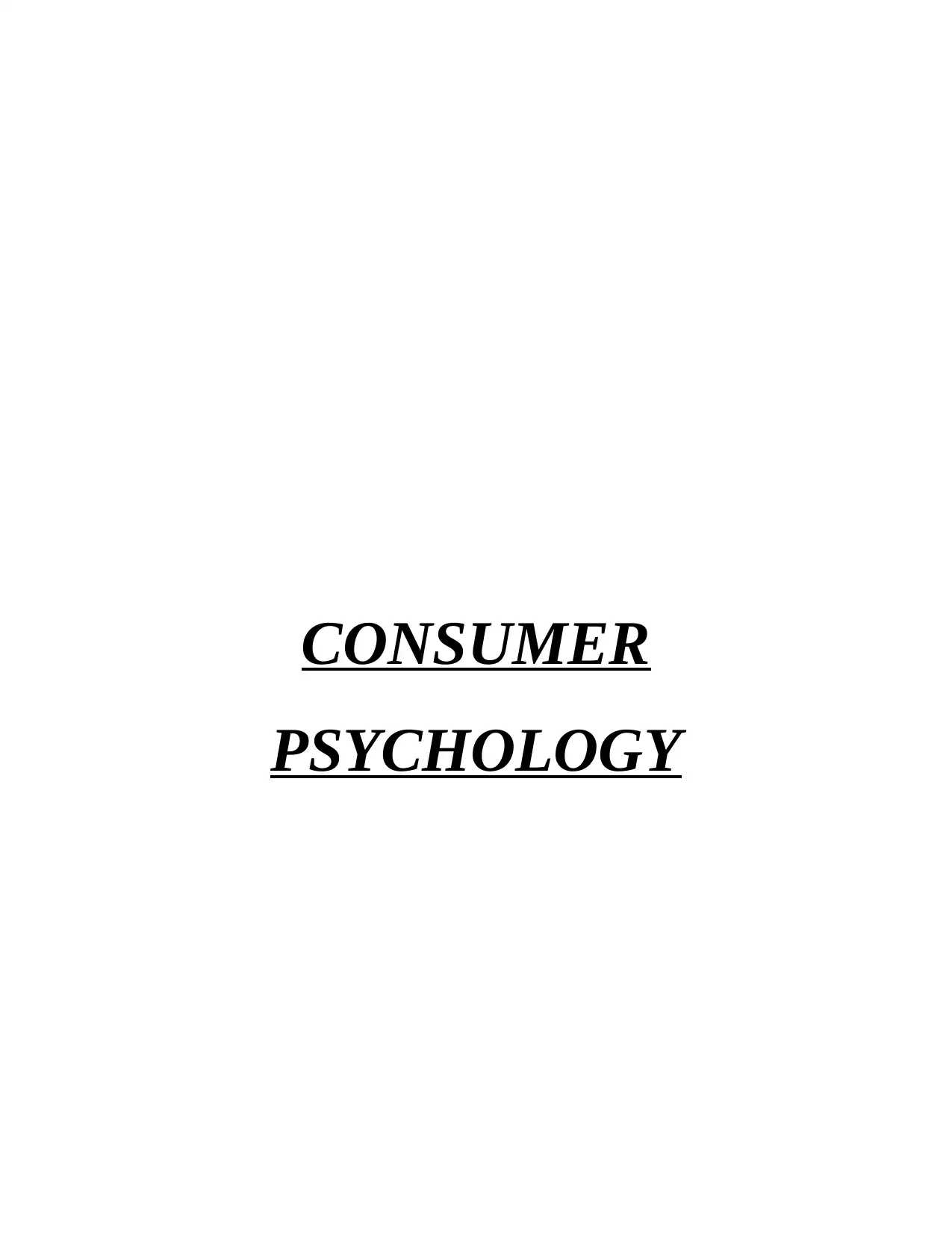
CONSUMER
PSYCHOLOGY
PSYCHOLOGY
Paraphrase This Document
Need a fresh take? Get an instant paraphrase of this document with our AI Paraphraser
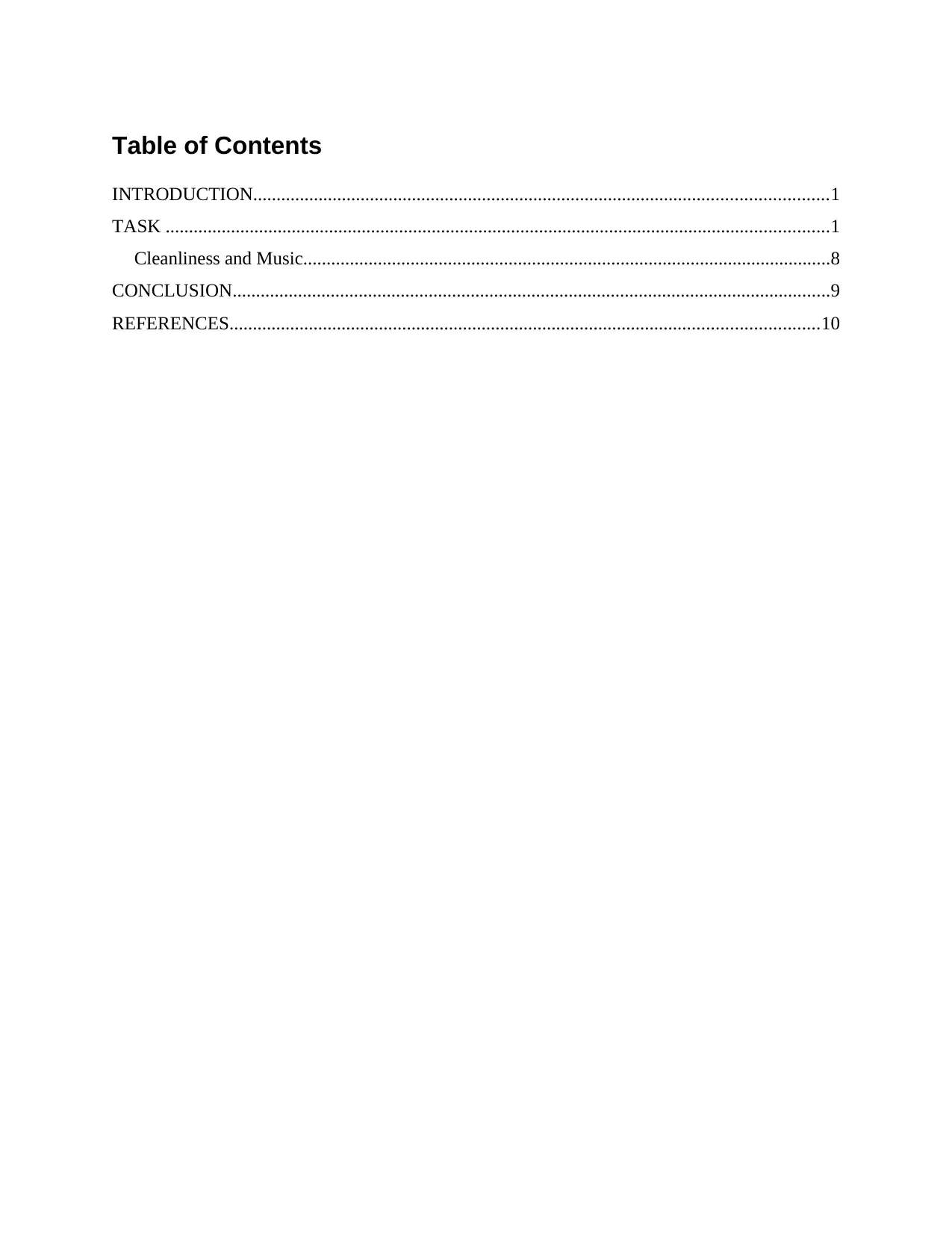
Table of Contents
INTRODUCTION...........................................................................................................................1
TASK ..............................................................................................................................................1
Cleanliness and Music.................................................................................................................8
CONCLUSION................................................................................................................................9
REFERENCES..............................................................................................................................10
INTRODUCTION...........................................................................................................................1
TASK ..............................................................................................................................................1
Cleanliness and Music.................................................................................................................8
CONCLUSION................................................................................................................................9
REFERENCES..............................................................................................................................10
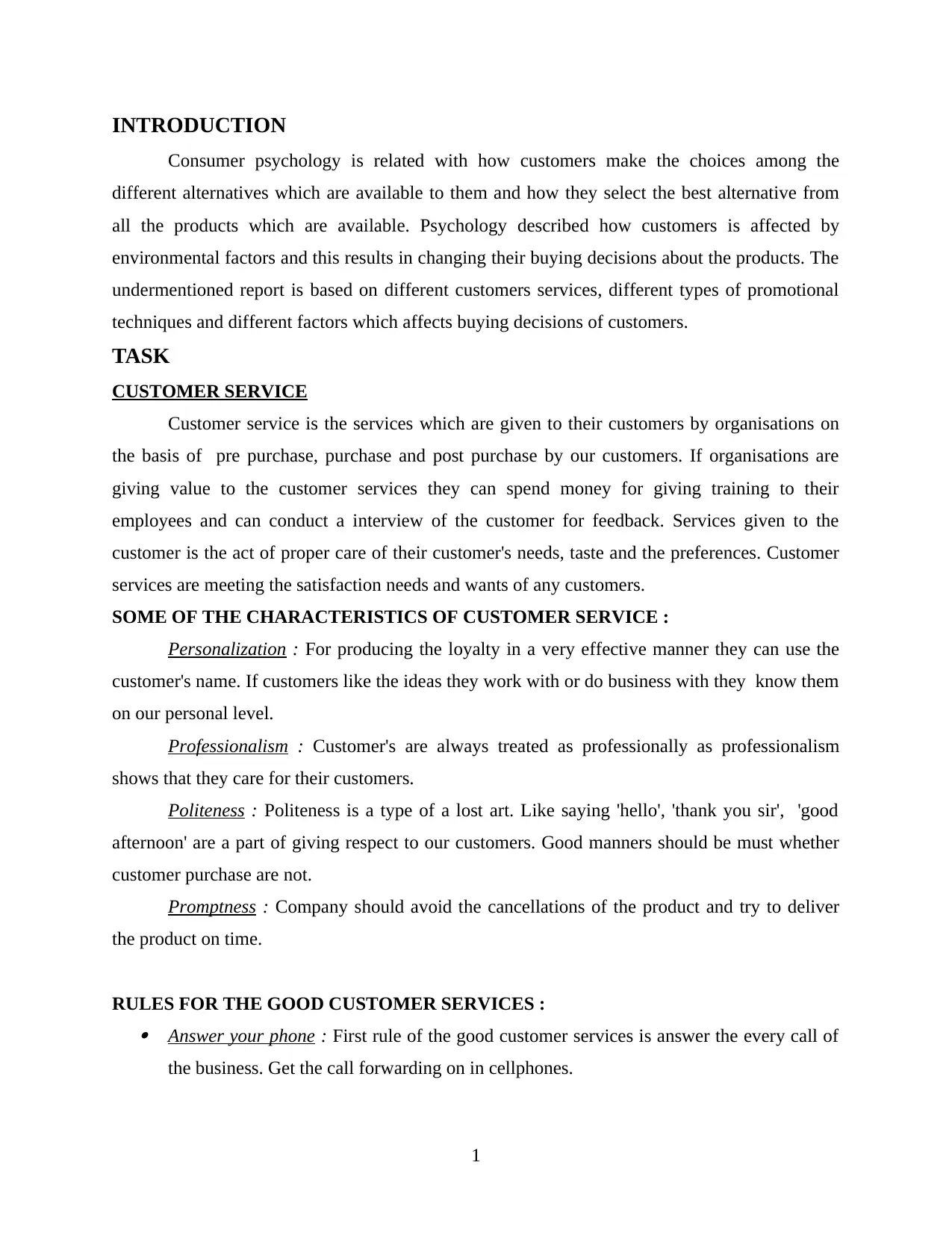
INTRODUCTION
Consumer psychology is related with how customers make the choices among the
different alternatives which are available to them and how they select the best alternative from
all the products which are available. Psychology described how customers is affected by
environmental factors and this results in changing their buying decisions about the products. The
undermentioned report is based on different customers services, different types of promotional
techniques and different factors which affects buying decisions of customers.
TASK
CUSTOMER SERVICE
Customer service is the services which are given to their customers by organisations on
the basis of pre purchase, purchase and post purchase by our customers. If organisations are
giving value to the customer services they can spend money for giving training to their
employees and can conduct a interview of the customer for feedback. Services given to the
customer is the act of proper care of their customer's needs, taste and the preferences. Customer
services are meeting the satisfaction needs and wants of any customers.
SOME OF THE CHARACTERISTICS OF CUSTOMER SERVICE :
Personalization : For producing the loyalty in a very effective manner they can use the
customer's name. If customers like the ideas they work with or do business with they know them
on our personal level.
Professionalism : Customer's are always treated as professionally as professionalism
shows that they care for their customers.
Politeness : Politeness is a type of a lost art. Like saying 'hello', 'thank you sir', 'good
afternoon' are a part of giving respect to our customers. Good manners should be must whether
customer purchase are not.
Promptness : Company should avoid the cancellations of the product and try to deliver
the product on time.
RULES FOR THE GOOD CUSTOMER SERVICES : Answer your phone : First rule of the good customer services is answer the every call of
the business. Get the call forwarding on in cellphones.
1
Consumer psychology is related with how customers make the choices among the
different alternatives which are available to them and how they select the best alternative from
all the products which are available. Psychology described how customers is affected by
environmental factors and this results in changing their buying decisions about the products. The
undermentioned report is based on different customers services, different types of promotional
techniques and different factors which affects buying decisions of customers.
TASK
CUSTOMER SERVICE
Customer service is the services which are given to their customers by organisations on
the basis of pre purchase, purchase and post purchase by our customers. If organisations are
giving value to the customer services they can spend money for giving training to their
employees and can conduct a interview of the customer for feedback. Services given to the
customer is the act of proper care of their customer's needs, taste and the preferences. Customer
services are meeting the satisfaction needs and wants of any customers.
SOME OF THE CHARACTERISTICS OF CUSTOMER SERVICE :
Personalization : For producing the loyalty in a very effective manner they can use the
customer's name. If customers like the ideas they work with or do business with they know them
on our personal level.
Professionalism : Customer's are always treated as professionally as professionalism
shows that they care for their customers.
Politeness : Politeness is a type of a lost art. Like saying 'hello', 'thank you sir', 'good
afternoon' are a part of giving respect to our customers. Good manners should be must whether
customer purchase are not.
Promptness : Company should avoid the cancellations of the product and try to deliver
the product on time.
RULES FOR THE GOOD CUSTOMER SERVICES : Answer your phone : First rule of the good customer services is answer the every call of
the business. Get the call forwarding on in cellphones.
1
⊘ This is a preview!⊘
Do you want full access?
Subscribe today to unlock all pages.

Trusted by 1+ million students worldwide
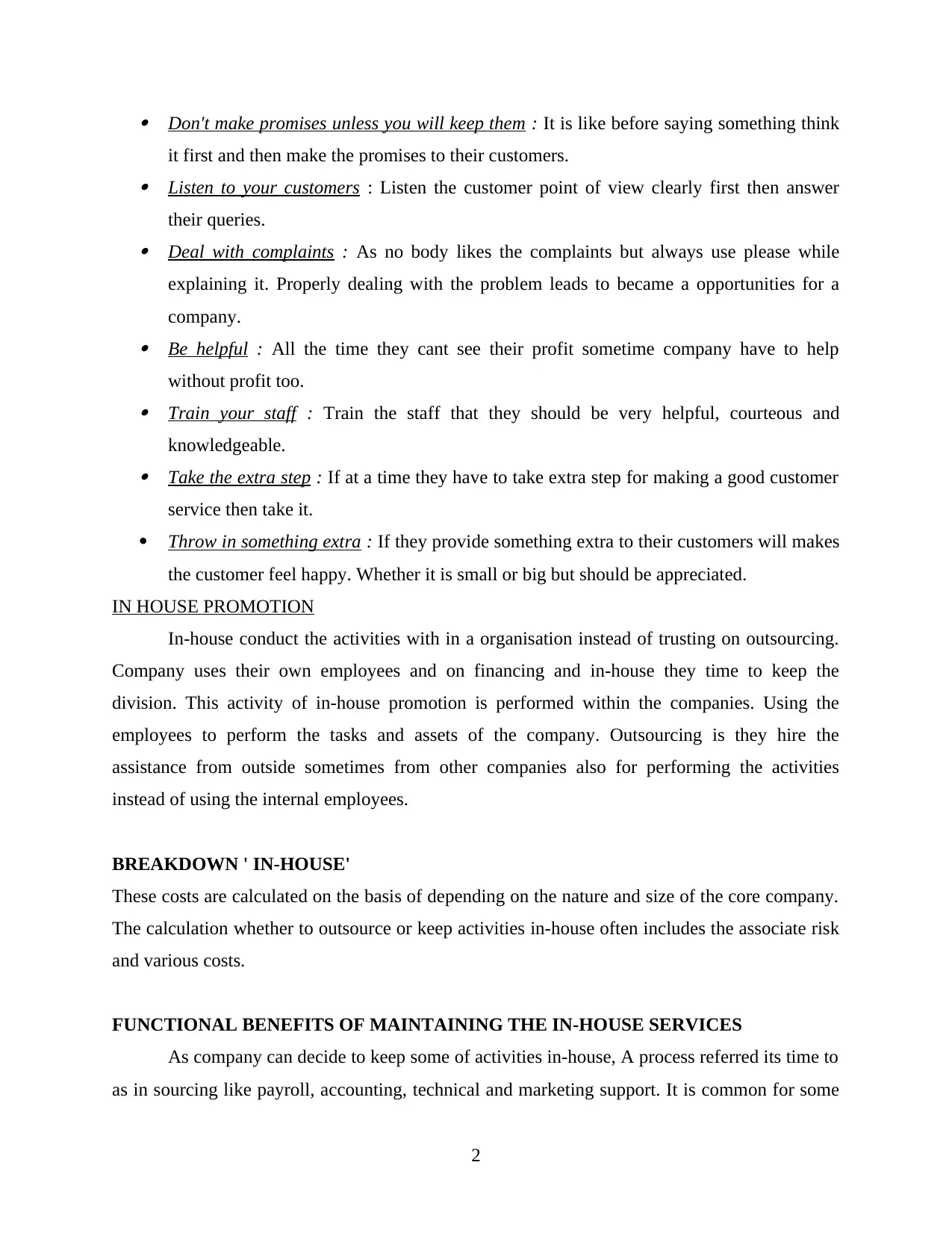
Don't make promises unless you will keep them : It is like before saying something think
it first and then make the promises to their customers. Listen to your customers : Listen the customer point of view clearly first then answer
their queries. Deal with complaints : As no body likes the complaints but always use please while
explaining it. Properly dealing with the problem leads to became a opportunities for a
company. Be helpful : All the time they cant see their profit sometime company have to help
without profit too. Train your staff : Train the staff that they should be very helpful, courteous and
knowledgeable. Take the extra step : If at a time they have to take extra step for making a good customer
service then take it.
Throw in something extra : If they provide something extra to their customers will makes
the customer feel happy. Whether it is small or big but should be appreciated.
IN HOUSE PROMOTION
In-house conduct the activities with in a organisation instead of trusting on outsourcing.
Company uses their own employees and on financing and in-house they time to keep the
division. This activity of in-house promotion is performed within the companies. Using the
employees to perform the tasks and assets of the company. Outsourcing is they hire the
assistance from outside sometimes from other companies also for performing the activities
instead of using the internal employees.
BREAKDOWN ' IN-HOUSE'
These costs are calculated on the basis of depending on the nature and size of the core company.
The calculation whether to outsource or keep activities in-house often includes the associate risk
and various costs.
FUNCTIONAL BENEFITS OF MAINTAINING THE IN-HOUSE SERVICES
As company can decide to keep some of activities in-house, A process referred its time to
as in sourcing like payroll, accounting, technical and marketing support. It is common for some
2
it first and then make the promises to their customers. Listen to your customers : Listen the customer point of view clearly first then answer
their queries. Deal with complaints : As no body likes the complaints but always use please while
explaining it. Properly dealing with the problem leads to became a opportunities for a
company. Be helpful : All the time they cant see their profit sometime company have to help
without profit too. Train your staff : Train the staff that they should be very helpful, courteous and
knowledgeable. Take the extra step : If at a time they have to take extra step for making a good customer
service then take it.
Throw in something extra : If they provide something extra to their customers will makes
the customer feel happy. Whether it is small or big but should be appreciated.
IN HOUSE PROMOTION
In-house conduct the activities with in a organisation instead of trusting on outsourcing.
Company uses their own employees and on financing and in-house they time to keep the
division. This activity of in-house promotion is performed within the companies. Using the
employees to perform the tasks and assets of the company. Outsourcing is they hire the
assistance from outside sometimes from other companies also for performing the activities
instead of using the internal employees.
BREAKDOWN ' IN-HOUSE'
These costs are calculated on the basis of depending on the nature and size of the core company.
The calculation whether to outsource or keep activities in-house often includes the associate risk
and various costs.
FUNCTIONAL BENEFITS OF MAINTAINING THE IN-HOUSE SERVICES
As company can decide to keep some of activities in-house, A process referred its time to
as in sourcing like payroll, accounting, technical and marketing support. It is common for some
2
Paraphrase This Document
Need a fresh take? Get an instant paraphrase of this document with our AI Paraphraser
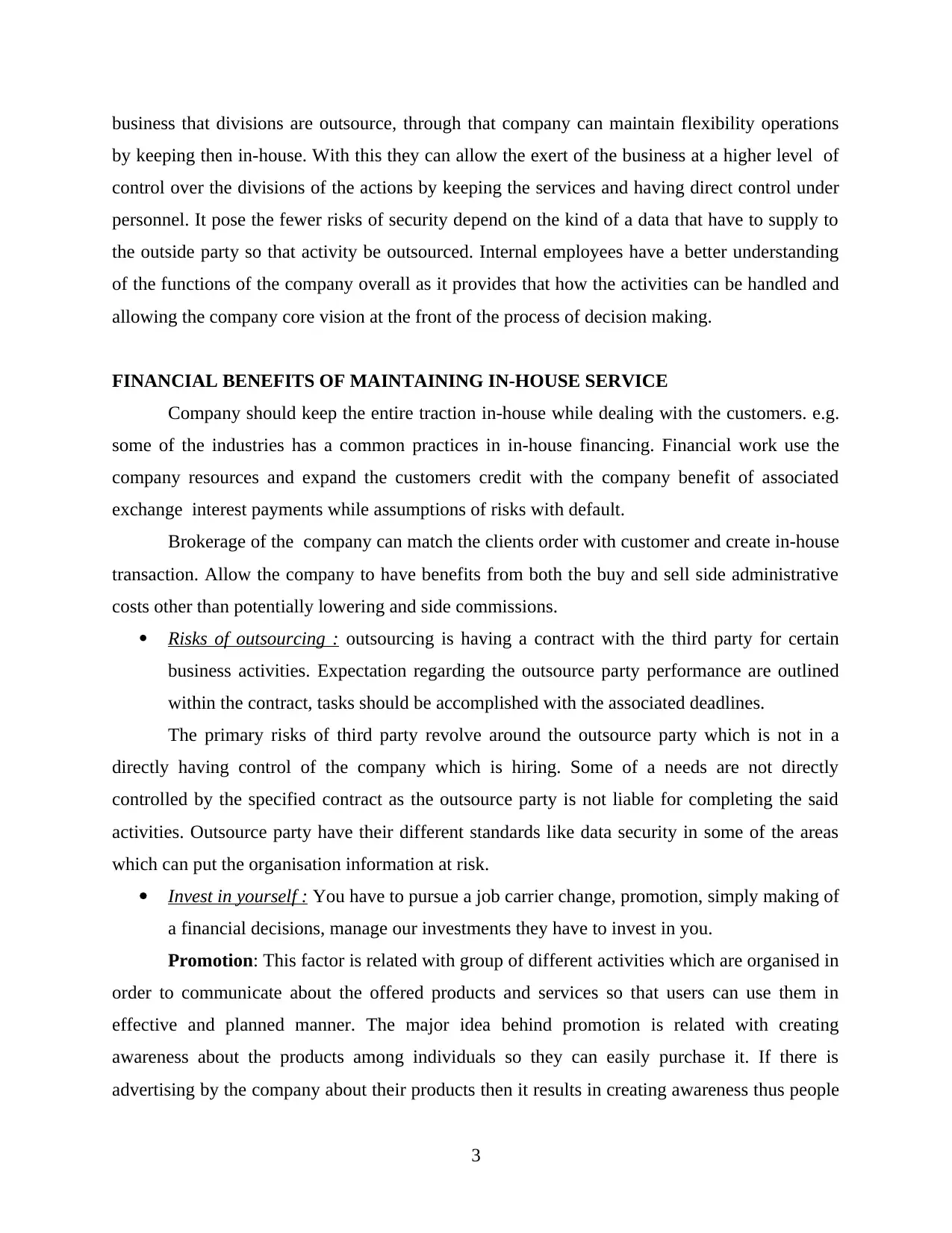
business that divisions are outsource, through that company can maintain flexibility operations
by keeping then in-house. With this they can allow the exert of the business at a higher level of
control over the divisions of the actions by keeping the services and having direct control under
personnel. It pose the fewer risks of security depend on the kind of a data that have to supply to
the outside party so that activity be outsourced. Internal employees have a better understanding
of the functions of the company overall as it provides that how the activities can be handled and
allowing the company core vision at the front of the process of decision making.
FINANCIAL BENEFITS OF MAINTAINING IN-HOUSE SERVICE
Company should keep the entire traction in-house while dealing with the customers. e.g.
some of the industries has a common practices in in-house financing. Financial work use the
company resources and expand the customers credit with the company benefit of associated
exchange interest payments while assumptions of risks with default.
Brokerage of the company can match the clients order with customer and create in-house
transaction. Allow the company to have benefits from both the buy and sell side administrative
costs other than potentially lowering and side commissions.
Risks of outsourcing : outsourcing is having a contract with the third party for certain
business activities. Expectation regarding the outsource party performance are outlined
within the contract, tasks should be accomplished with the associated deadlines.
The primary risks of third party revolve around the outsource party which is not in a
directly having control of the company which is hiring. Some of a needs are not directly
controlled by the specified contract as the outsource party is not liable for completing the said
activities. Outsource party have their different standards like data security in some of the areas
which can put the organisation information at risk.
Invest in yourself : You have to pursue a job carrier change, promotion, simply making of
a financial decisions, manage our investments they have to invest in you.
Promotion: This factor is related with group of different activities which are organised in
order to communicate about the offered products and services so that users can use them in
effective and planned manner. The major idea behind promotion is related with creating
awareness about the products among individuals so they can easily purchase it. If there is
advertising by the company about their products then it results in creating awareness thus people
3
by keeping then in-house. With this they can allow the exert of the business at a higher level of
control over the divisions of the actions by keeping the services and having direct control under
personnel. It pose the fewer risks of security depend on the kind of a data that have to supply to
the outside party so that activity be outsourced. Internal employees have a better understanding
of the functions of the company overall as it provides that how the activities can be handled and
allowing the company core vision at the front of the process of decision making.
FINANCIAL BENEFITS OF MAINTAINING IN-HOUSE SERVICE
Company should keep the entire traction in-house while dealing with the customers. e.g.
some of the industries has a common practices in in-house financing. Financial work use the
company resources and expand the customers credit with the company benefit of associated
exchange interest payments while assumptions of risks with default.
Brokerage of the company can match the clients order with customer and create in-house
transaction. Allow the company to have benefits from both the buy and sell side administrative
costs other than potentially lowering and side commissions.
Risks of outsourcing : outsourcing is having a contract with the third party for certain
business activities. Expectation regarding the outsource party performance are outlined
within the contract, tasks should be accomplished with the associated deadlines.
The primary risks of third party revolve around the outsource party which is not in a
directly having control of the company which is hiring. Some of a needs are not directly
controlled by the specified contract as the outsource party is not liable for completing the said
activities. Outsource party have their different standards like data security in some of the areas
which can put the organisation information at risk.
Invest in yourself : You have to pursue a job carrier change, promotion, simply making of
a financial decisions, manage our investments they have to invest in you.
Promotion: This factor is related with group of different activities which are organised in
order to communicate about the offered products and services so that users can use them in
effective and planned manner. The major idea behind promotion is related with creating
awareness about the products among individuals so they can easily purchase it. If there is
advertising by the company about their products then it results in creating awareness thus people
3
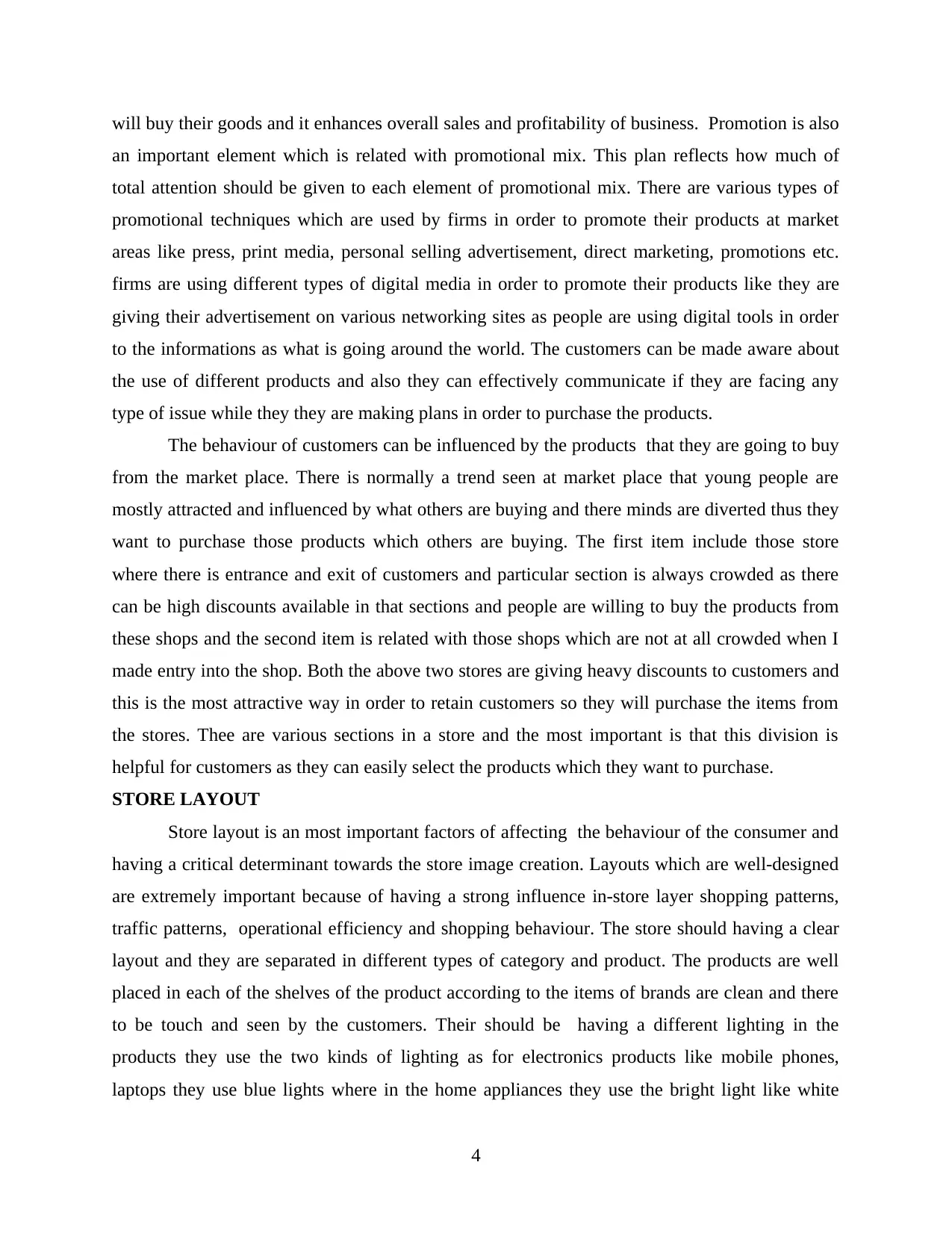
will buy their goods and it enhances overall sales and profitability of business. Promotion is also
an important element which is related with promotional mix. This plan reflects how much of
total attention should be given to each element of promotional mix. There are various types of
promotional techniques which are used by firms in order to promote their products at market
areas like press, print media, personal selling advertisement, direct marketing, promotions etc.
firms are using different types of digital media in order to promote their products like they are
giving their advertisement on various networking sites as people are using digital tools in order
to the informations as what is going around the world. The customers can be made aware about
the use of different products and also they can effectively communicate if they are facing any
type of issue while they they are making plans in order to purchase the products.
The behaviour of customers can be influenced by the products that they are going to buy
from the market place. There is normally a trend seen at market place that young people are
mostly attracted and influenced by what others are buying and there minds are diverted thus they
want to purchase those products which others are buying. The first item include those store
where there is entrance and exit of customers and particular section is always crowded as there
can be high discounts available in that sections and people are willing to buy the products from
these shops and the second item is related with those shops which are not at all crowded when I
made entry into the shop. Both the above two stores are giving heavy discounts to customers and
this is the most attractive way in order to retain customers so they will purchase the items from
the stores. Thee are various sections in a store and the most important is that this division is
helpful for customers as they can easily select the products which they want to purchase.
STORE LAYOUT
Store layout is an most important factors of affecting the behaviour of the consumer and
having a critical determinant towards the store image creation. Layouts which are well-designed
are extremely important because of having a strong influence in-store layer shopping patterns,
traffic patterns, operational efficiency and shopping behaviour. The store should having a clear
layout and they are separated in different types of category and product. The products are well
placed in each of the shelves of the product according to the items of brands are clean and there
to be touch and seen by the customers. Their should be having a different lighting in the
products they use the two kinds of lighting as for electronics products like mobile phones,
laptops they use blue lights where in the home appliances they use the bright light like white
4
an important element which is related with promotional mix. This plan reflects how much of
total attention should be given to each element of promotional mix. There are various types of
promotional techniques which are used by firms in order to promote their products at market
areas like press, print media, personal selling advertisement, direct marketing, promotions etc.
firms are using different types of digital media in order to promote their products like they are
giving their advertisement on various networking sites as people are using digital tools in order
to the informations as what is going around the world. The customers can be made aware about
the use of different products and also they can effectively communicate if they are facing any
type of issue while they they are making plans in order to purchase the products.
The behaviour of customers can be influenced by the products that they are going to buy
from the market place. There is normally a trend seen at market place that young people are
mostly attracted and influenced by what others are buying and there minds are diverted thus they
want to purchase those products which others are buying. The first item include those store
where there is entrance and exit of customers and particular section is always crowded as there
can be high discounts available in that sections and people are willing to buy the products from
these shops and the second item is related with those shops which are not at all crowded when I
made entry into the shop. Both the above two stores are giving heavy discounts to customers and
this is the most attractive way in order to retain customers so they will purchase the items from
the stores. Thee are various sections in a store and the most important is that this division is
helpful for customers as they can easily select the products which they want to purchase.
STORE LAYOUT
Store layout is an most important factors of affecting the behaviour of the consumer and
having a critical determinant towards the store image creation. Layouts which are well-designed
are extremely important because of having a strong influence in-store layer shopping patterns,
traffic patterns, operational efficiency and shopping behaviour. The store should having a clear
layout and they are separated in different types of category and product. The products are well
placed in each of the shelves of the product according to the items of brands are clean and there
to be touch and seen by the customers. Their should be having a different lighting in the
products they use the two kinds of lighting as for electronics products like mobile phones,
laptops they use blue lights where in the home appliances they use the bright light like white
4
⊘ This is a preview!⊘
Do you want full access?
Subscribe today to unlock all pages.

Trusted by 1+ million students worldwide
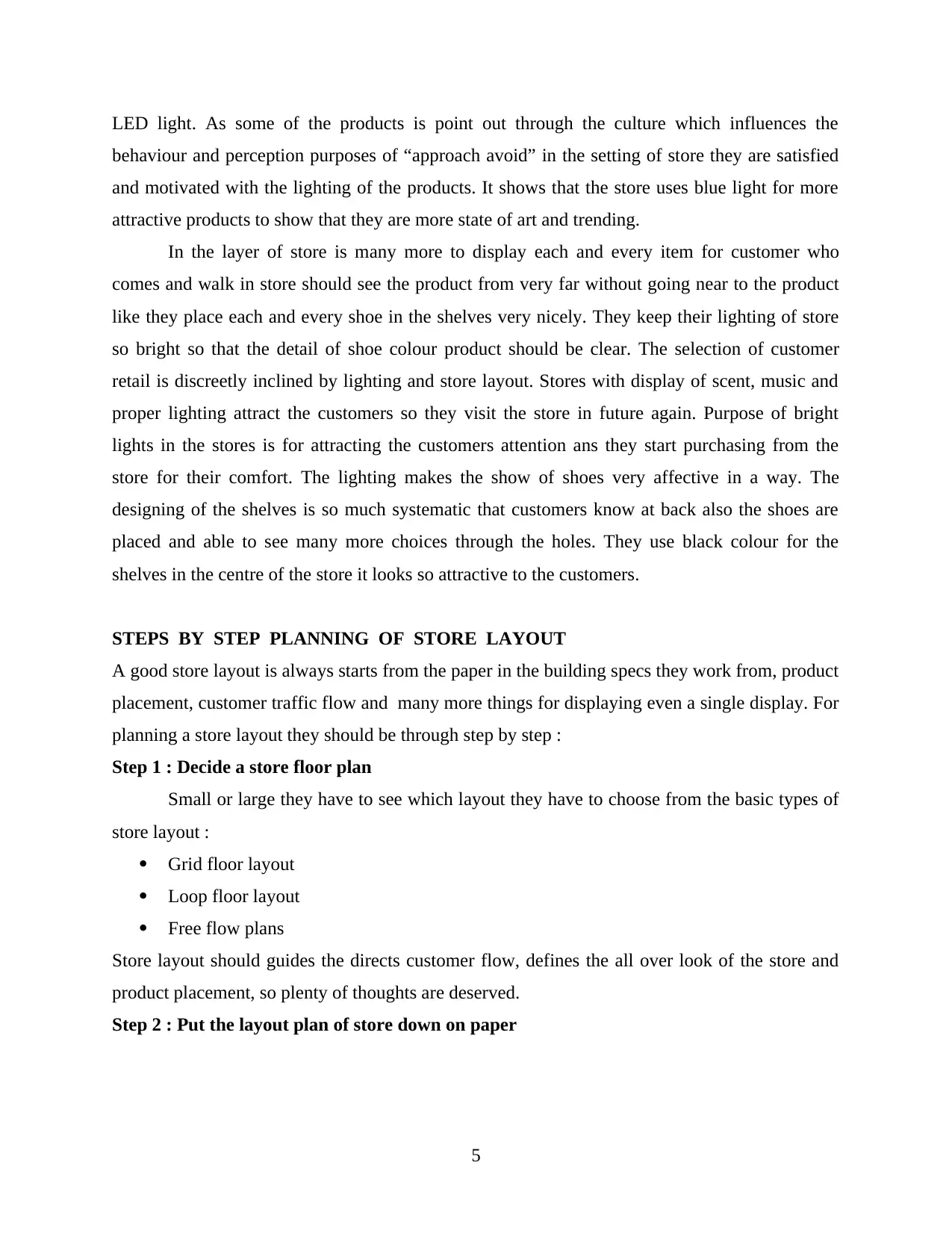
LED light. As some of the products is point out through the culture which influences the
behaviour and perception purposes of “approach avoid” in the setting of store they are satisfied
and motivated with the lighting of the products. It shows that the store uses blue light for more
attractive products to show that they are more state of art and trending.
In the layer of store is many more to display each and every item for customer who
comes and walk in store should see the product from very far without going near to the product
like they place each and every shoe in the shelves very nicely. They keep their lighting of store
so bright so that the detail of shoe colour product should be clear. The selection of customer
retail is discreetly inclined by lighting and store layout. Stores with display of scent, music and
proper lighting attract the customers so they visit the store in future again. Purpose of bright
lights in the stores is for attracting the customers attention ans they start purchasing from the
store for their comfort. The lighting makes the show of shoes very affective in a way. The
designing of the shelves is so much systematic that customers know at back also the shoes are
placed and able to see many more choices through the holes. They use black colour for the
shelves in the centre of the store it looks so attractive to the customers.
STEPS BY STEP PLANNING OF STORE LAYOUT
A good store layout is always starts from the paper in the building specs they work from, product
placement, customer traffic flow and many more things for displaying even a single display. For
planning a store layout they should be through step by step :
Step 1 : Decide a store floor plan
Small or large they have to see which layout they have to choose from the basic types of
store layout :
Grid floor layout
Loop floor layout
Free flow plans
Store layout should guides the directs customer flow, defines the all over look of the store and
product placement, so plenty of thoughts are deserved.
Step 2 : Put the layout plan of store down on paper
5
behaviour and perception purposes of “approach avoid” in the setting of store they are satisfied
and motivated with the lighting of the products. It shows that the store uses blue light for more
attractive products to show that they are more state of art and trending.
In the layer of store is many more to display each and every item for customer who
comes and walk in store should see the product from very far without going near to the product
like they place each and every shoe in the shelves very nicely. They keep their lighting of store
so bright so that the detail of shoe colour product should be clear. The selection of customer
retail is discreetly inclined by lighting and store layout. Stores with display of scent, music and
proper lighting attract the customers so they visit the store in future again. Purpose of bright
lights in the stores is for attracting the customers attention ans they start purchasing from the
store for their comfort. The lighting makes the show of shoes very affective in a way. The
designing of the shelves is so much systematic that customers know at back also the shoes are
placed and able to see many more choices through the holes. They use black colour for the
shelves in the centre of the store it looks so attractive to the customers.
STEPS BY STEP PLANNING OF STORE LAYOUT
A good store layout is always starts from the paper in the building specs they work from, product
placement, customer traffic flow and many more things for displaying even a single display. For
planning a store layout they should be through step by step :
Step 1 : Decide a store floor plan
Small or large they have to see which layout they have to choose from the basic types of
store layout :
Grid floor layout
Loop floor layout
Free flow plans
Store layout should guides the directs customer flow, defines the all over look of the store and
product placement, so plenty of thoughts are deserved.
Step 2 : Put the layout plan of store down on paper
5
Paraphrase This Document
Need a fresh take? Get an instant paraphrase of this document with our AI Paraphraser
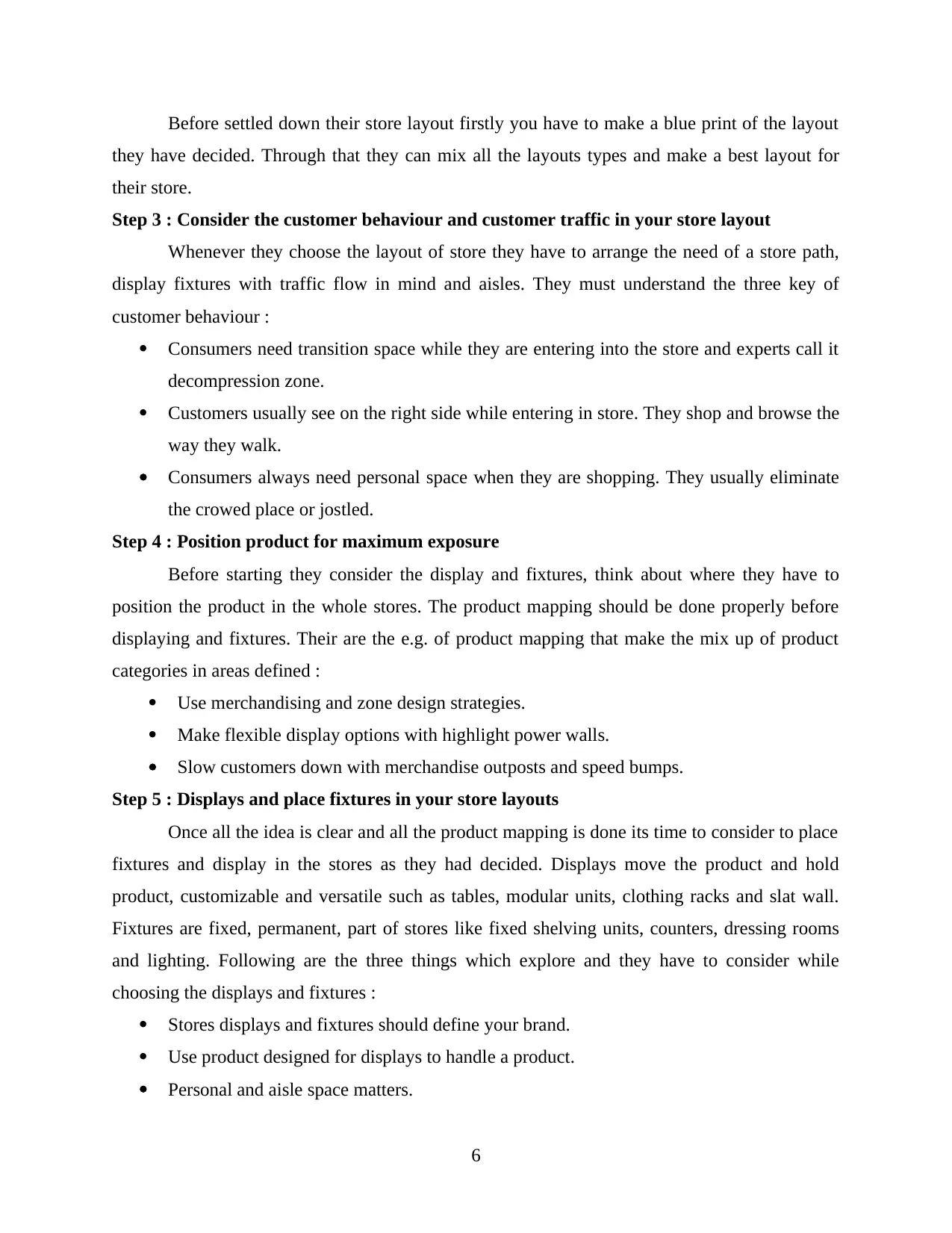
Before settled down their store layout firstly you have to make a blue print of the layout
they have decided. Through that they can mix all the layouts types and make a best layout for
their store.
Step 3 : Consider the customer behaviour and customer traffic in your store layout
Whenever they choose the layout of store they have to arrange the need of a store path,
display fixtures with traffic flow in mind and aisles. They must understand the three key of
customer behaviour :
Consumers need transition space while they are entering into the store and experts call it
decompression zone.
Customers usually see on the right side while entering in store. They shop and browse the
way they walk.
Consumers always need personal space when they are shopping. They usually eliminate
the crowed place or jostled.
Step 4 : Position product for maximum exposure
Before starting they consider the display and fixtures, think about where they have to
position the product in the whole stores. The product mapping should be done properly before
displaying and fixtures. Their are the e.g. of product mapping that make the mix up of product
categories in areas defined :
Use merchandising and zone design strategies.
Make flexible display options with highlight power walls.
Slow customers down with merchandise outposts and speed bumps.
Step 5 : Displays and place fixtures in your store layouts
Once all the idea is clear and all the product mapping is done its time to consider to place
fixtures and display in the stores as they had decided. Displays move the product and hold
product, customizable and versatile such as tables, modular units, clothing racks and slat wall.
Fixtures are fixed, permanent, part of stores like fixed shelving units, counters, dressing rooms
and lighting. Following are the three things which explore and they have to consider while
choosing the displays and fixtures :
Stores displays and fixtures should define your brand.
Use product designed for displays to handle a product.
Personal and aisle space matters.
6
they have decided. Through that they can mix all the layouts types and make a best layout for
their store.
Step 3 : Consider the customer behaviour and customer traffic in your store layout
Whenever they choose the layout of store they have to arrange the need of a store path,
display fixtures with traffic flow in mind and aisles. They must understand the three key of
customer behaviour :
Consumers need transition space while they are entering into the store and experts call it
decompression zone.
Customers usually see on the right side while entering in store. They shop and browse the
way they walk.
Consumers always need personal space when they are shopping. They usually eliminate
the crowed place or jostled.
Step 4 : Position product for maximum exposure
Before starting they consider the display and fixtures, think about where they have to
position the product in the whole stores. The product mapping should be done properly before
displaying and fixtures. Their are the e.g. of product mapping that make the mix up of product
categories in areas defined :
Use merchandising and zone design strategies.
Make flexible display options with highlight power walls.
Slow customers down with merchandise outposts and speed bumps.
Step 5 : Displays and place fixtures in your store layouts
Once all the idea is clear and all the product mapping is done its time to consider to place
fixtures and display in the stores as they had decided. Displays move the product and hold
product, customizable and versatile such as tables, modular units, clothing racks and slat wall.
Fixtures are fixed, permanent, part of stores like fixed shelving units, counters, dressing rooms
and lighting. Following are the three things which explore and they have to consider while
choosing the displays and fixtures :
Stores displays and fixtures should define your brand.
Use product designed for displays to handle a product.
Personal and aisle space matters.
6
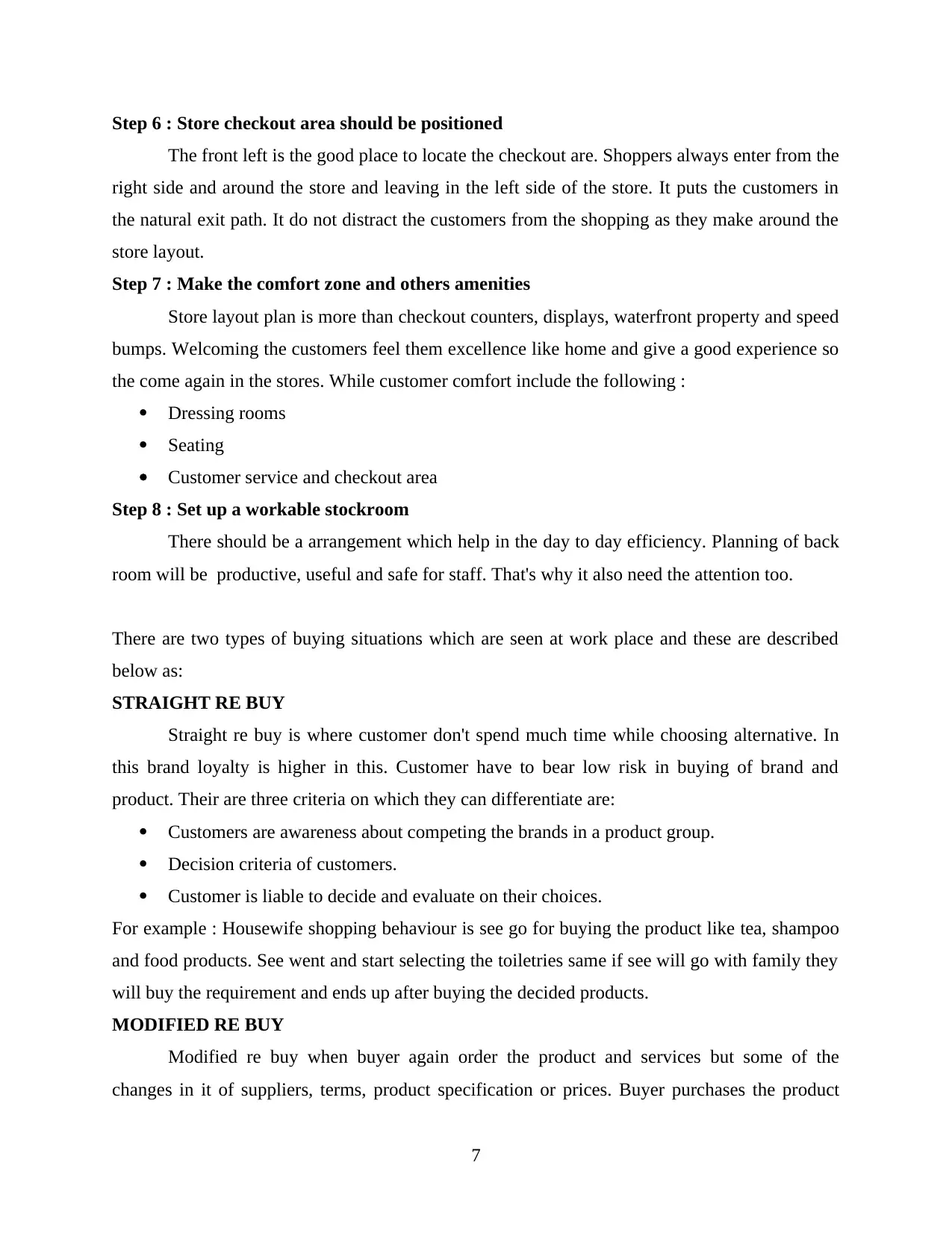
Step 6 : Store checkout area should be positioned
The front left is the good place to locate the checkout are. Shoppers always enter from the
right side and around the store and leaving in the left side of the store. It puts the customers in
the natural exit path. It do not distract the customers from the shopping as they make around the
store layout.
Step 7 : Make the comfort zone and others amenities
Store layout plan is more than checkout counters, displays, waterfront property and speed
bumps. Welcoming the customers feel them excellence like home and give a good experience so
the come again in the stores. While customer comfort include the following :
Dressing rooms
Seating
Customer service and checkout area
Step 8 : Set up a workable stockroom
There should be a arrangement which help in the day to day efficiency. Planning of back
room will be productive, useful and safe for staff. That's why it also need the attention too.
There are two types of buying situations which are seen at work place and these are described
below as:
STRAIGHT RE BUY
Straight re buy is where customer don't spend much time while choosing alternative. In
this brand loyalty is higher in this. Customer have to bear low risk in buying of brand and
product. Their are three criteria on which they can differentiate are:
Customers are awareness about competing the brands in a product group.
Decision criteria of customers.
Customer is liable to decide and evaluate on their choices.
For example : Housewife shopping behaviour is see go for buying the product like tea, shampoo
and food products. See went and start selecting the toiletries same if see will go with family they
will buy the requirement and ends up after buying the decided products.
MODIFIED RE BUY
Modified re buy when buyer again order the product and services but some of the
changes in it of suppliers, terms, product specification or prices. Buyer purchases the product
7
The front left is the good place to locate the checkout are. Shoppers always enter from the
right side and around the store and leaving in the left side of the store. It puts the customers in
the natural exit path. It do not distract the customers from the shopping as they make around the
store layout.
Step 7 : Make the comfort zone and others amenities
Store layout plan is more than checkout counters, displays, waterfront property and speed
bumps. Welcoming the customers feel them excellence like home and give a good experience so
the come again in the stores. While customer comfort include the following :
Dressing rooms
Seating
Customer service and checkout area
Step 8 : Set up a workable stockroom
There should be a arrangement which help in the day to day efficiency. Planning of back
room will be productive, useful and safe for staff. That's why it also need the attention too.
There are two types of buying situations which are seen at work place and these are described
below as:
STRAIGHT RE BUY
Straight re buy is where customer don't spend much time while choosing alternative. In
this brand loyalty is higher in this. Customer have to bear low risk in buying of brand and
product. Their are three criteria on which they can differentiate are:
Customers are awareness about competing the brands in a product group.
Decision criteria of customers.
Customer is liable to decide and evaluate on their choices.
For example : Housewife shopping behaviour is see go for buying the product like tea, shampoo
and food products. See went and start selecting the toiletries same if see will go with family they
will buy the requirement and ends up after buying the decided products.
MODIFIED RE BUY
Modified re buy when buyer again order the product and services but some of the
changes in it of suppliers, terms, product specification or prices. Buyer purchases the product
7
⊘ This is a preview!⊘
Do you want full access?
Subscribe today to unlock all pages.

Trusted by 1+ million students worldwide
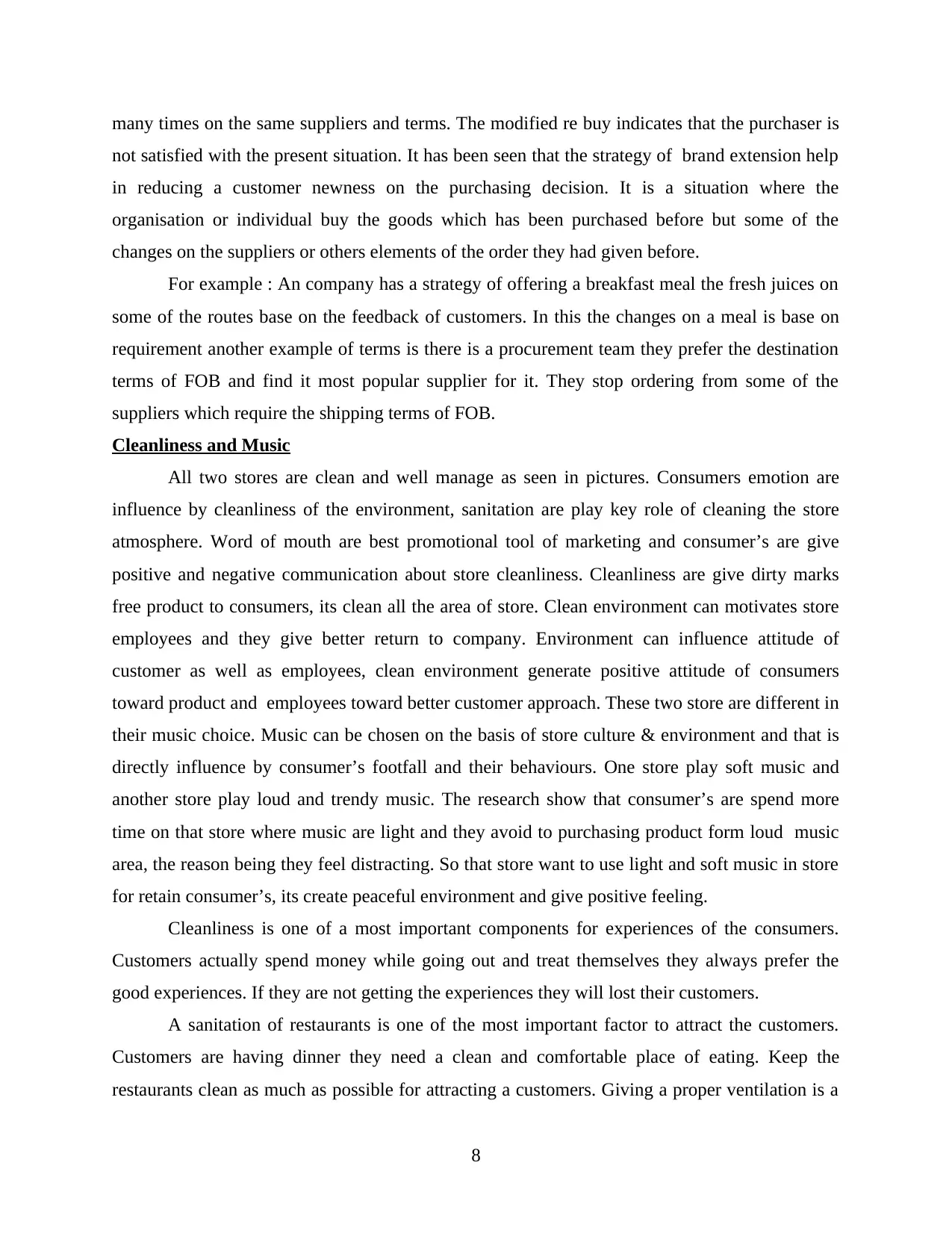
many times on the same suppliers and terms. The modified re buy indicates that the purchaser is
not satisfied with the present situation. It has been seen that the strategy of brand extension help
in reducing a customer newness on the purchasing decision. It is a situation where the
organisation or individual buy the goods which has been purchased before but some of the
changes on the suppliers or others elements of the order they had given before.
For example : An company has a strategy of offering a breakfast meal the fresh juices on
some of the routes base on the feedback of customers. In this the changes on a meal is base on
requirement another example of terms is there is a procurement team they prefer the destination
terms of FOB and find it most popular supplier for it. They stop ordering from some of the
suppliers which require the shipping terms of FOB.
Cleanliness and Music
All two stores are clean and well manage as seen in pictures. Consumers emotion are
influence by cleanliness of the environment, sanitation are play key role of cleaning the store
atmosphere. Word of mouth are best promotional tool of marketing and consumer’s are give
positive and negative communication about store cleanliness. Cleanliness are give dirty marks
free product to consumers, its clean all the area of store. Clean environment can motivates store
employees and they give better return to company. Environment can influence attitude of
customer as well as employees, clean environment generate positive attitude of consumers
toward product and employees toward better customer approach. These two store are different in
their music choice. Music can be chosen on the basis of store culture & environment and that is
directly influence by consumer’s footfall and their behaviours. One store play soft music and
another store play loud and trendy music. The research show that consumer’s are spend more
time on that store where music are light and they avoid to purchasing product form loud music
area, the reason being they feel distracting. So that store want to use light and soft music in store
for retain consumer’s, its create peaceful environment and give positive feeling.
Cleanliness is one of a most important components for experiences of the consumers.
Customers actually spend money while going out and treat themselves they always prefer the
good experiences. If they are not getting the experiences they will lost their customers.
A sanitation of restaurants is one of the most important factor to attract the customers.
Customers are having dinner they need a clean and comfortable place of eating. Keep the
restaurants clean as much as possible for attracting a customers. Giving a proper ventilation is a
8
not satisfied with the present situation. It has been seen that the strategy of brand extension help
in reducing a customer newness on the purchasing decision. It is a situation where the
organisation or individual buy the goods which has been purchased before but some of the
changes on the suppliers or others elements of the order they had given before.
For example : An company has a strategy of offering a breakfast meal the fresh juices on
some of the routes base on the feedback of customers. In this the changes on a meal is base on
requirement another example of terms is there is a procurement team they prefer the destination
terms of FOB and find it most popular supplier for it. They stop ordering from some of the
suppliers which require the shipping terms of FOB.
Cleanliness and Music
All two stores are clean and well manage as seen in pictures. Consumers emotion are
influence by cleanliness of the environment, sanitation are play key role of cleaning the store
atmosphere. Word of mouth are best promotional tool of marketing and consumer’s are give
positive and negative communication about store cleanliness. Cleanliness are give dirty marks
free product to consumers, its clean all the area of store. Clean environment can motivates store
employees and they give better return to company. Environment can influence attitude of
customer as well as employees, clean environment generate positive attitude of consumers
toward product and employees toward better customer approach. These two store are different in
their music choice. Music can be chosen on the basis of store culture & environment and that is
directly influence by consumer’s footfall and their behaviours. One store play soft music and
another store play loud and trendy music. The research show that consumer’s are spend more
time on that store where music are light and they avoid to purchasing product form loud music
area, the reason being they feel distracting. So that store want to use light and soft music in store
for retain consumer’s, its create peaceful environment and give positive feeling.
Cleanliness is one of a most important components for experiences of the consumers.
Customers actually spend money while going out and treat themselves they always prefer the
good experiences. If they are not getting the experiences they will lost their customers.
A sanitation of restaurants is one of the most important factor to attract the customers.
Customers are having dinner they need a clean and comfortable place of eating. Keep the
restaurants clean as much as possible for attracting a customers. Giving a proper ventilation is a
8
Paraphrase This Document
Need a fresh take? Get an instant paraphrase of this document with our AI Paraphraser
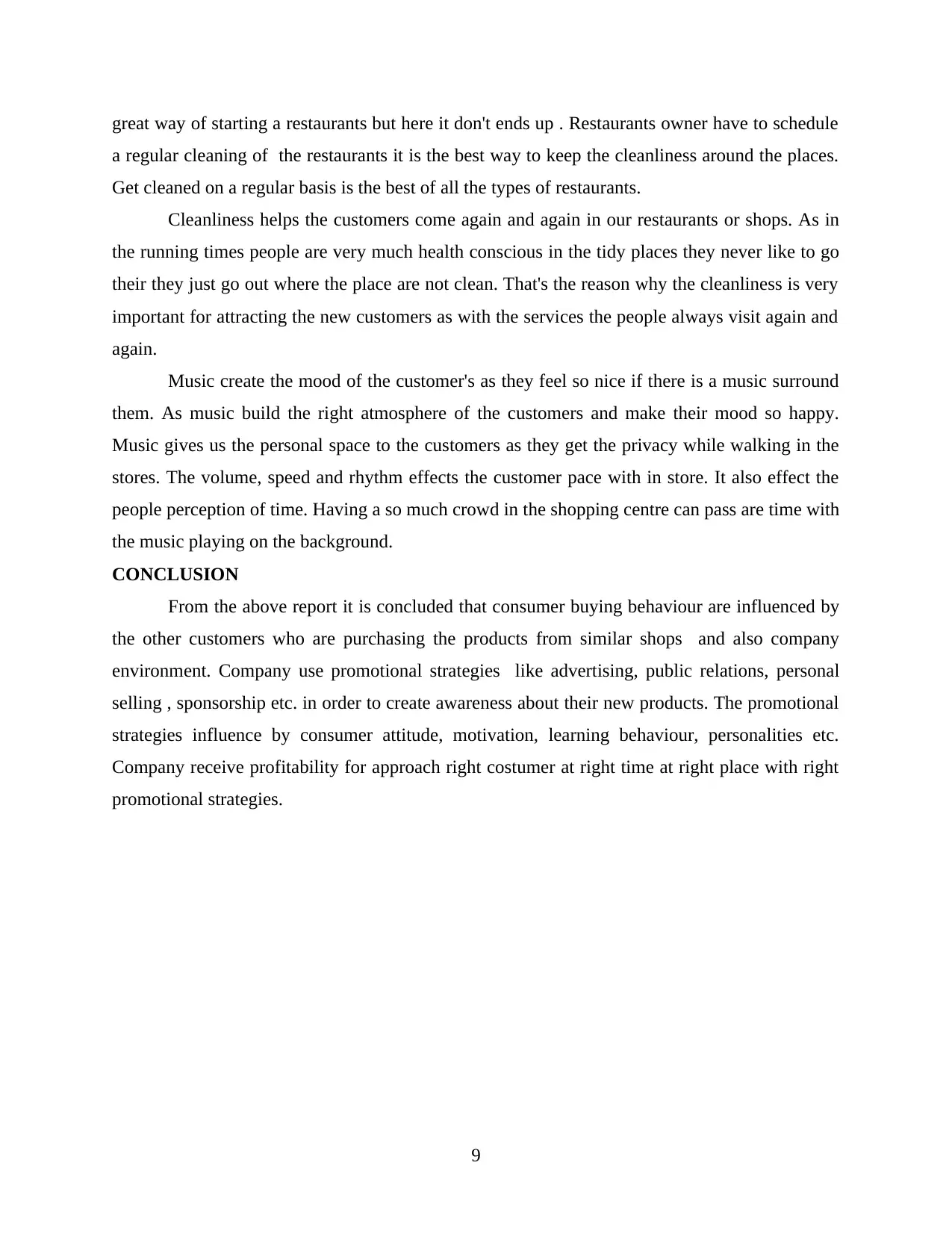
great way of starting a restaurants but here it don't ends up . Restaurants owner have to schedule
a regular cleaning of the restaurants it is the best way to keep the cleanliness around the places.
Get cleaned on a regular basis is the best of all the types of restaurants.
Cleanliness helps the customers come again and again in our restaurants or shops. As in
the running times people are very much health conscious in the tidy places they never like to go
their they just go out where the place are not clean. That's the reason why the cleanliness is very
important for attracting the new customers as with the services the people always visit again and
again.
Music create the mood of the customer's as they feel so nice if there is a music surround
them. As music build the right atmosphere of the customers and make their mood so happy.
Music gives us the personal space to the customers as they get the privacy while walking in the
stores. The volume, speed and rhythm effects the customer pace with in store. It also effect the
people perception of time. Having a so much crowd in the shopping centre can pass are time with
the music playing on the background.
CONCLUSION
From the above report it is concluded that consumer buying behaviour are influenced by
the other customers who are purchasing the products from similar shops and also company
environment. Company use promotional strategies like advertising, public relations, personal
selling , sponsorship etc. in order to create awareness about their new products. The promotional
strategies influence by consumer attitude, motivation, learning behaviour, personalities etc.
Company receive profitability for approach right costumer at right time at right place with right
promotional strategies.
9
a regular cleaning of the restaurants it is the best way to keep the cleanliness around the places.
Get cleaned on a regular basis is the best of all the types of restaurants.
Cleanliness helps the customers come again and again in our restaurants or shops. As in
the running times people are very much health conscious in the tidy places they never like to go
their they just go out where the place are not clean. That's the reason why the cleanliness is very
important for attracting the new customers as with the services the people always visit again and
again.
Music create the mood of the customer's as they feel so nice if there is a music surround
them. As music build the right atmosphere of the customers and make their mood so happy.
Music gives us the personal space to the customers as they get the privacy while walking in the
stores. The volume, speed and rhythm effects the customer pace with in store. It also effect the
people perception of time. Having a so much crowd in the shopping centre can pass are time with
the music playing on the background.
CONCLUSION
From the above report it is concluded that consumer buying behaviour are influenced by
the other customers who are purchasing the products from similar shops and also company
environment. Company use promotional strategies like advertising, public relations, personal
selling , sponsorship etc. in order to create awareness about their new products. The promotional
strategies influence by consumer attitude, motivation, learning behaviour, personalities etc.
Company receive profitability for approach right costumer at right time at right place with right
promotional strategies.
9
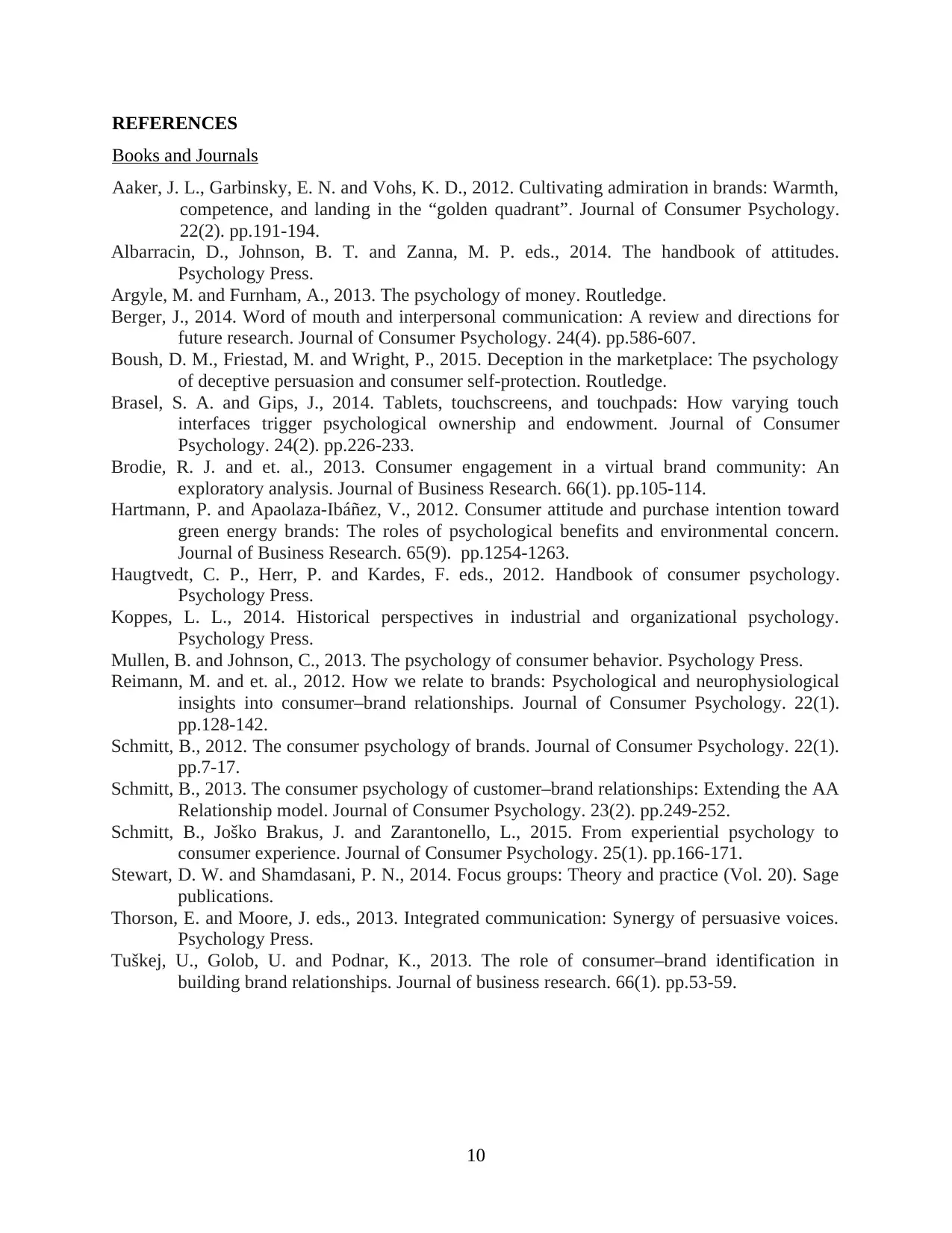
REFERENCES
Books and Journals
Aaker, J. L., Garbinsky, E. N. and Vohs, K. D., 2012. Cultivating admiration in brands: Warmth,
competence, and landing in the “golden quadrant”. Journal of Consumer Psychology.
22(2). pp.191-194.
Albarracin, D., Johnson, B. T. and Zanna, M. P. eds., 2014. The handbook of attitudes.
Psychology Press.
Argyle, M. and Furnham, A., 2013. The psychology of money. Routledge.
Berger, J., 2014. Word of mouth and interpersonal communication: A review and directions for
future research. Journal of Consumer Psychology. 24(4). pp.586-607.
Boush, D. M., Friestad, M. and Wright, P., 2015. Deception in the marketplace: The psychology
of deceptive persuasion and consumer self-protection. Routledge.
Brasel, S. A. and Gips, J., 2014. Tablets, touchscreens, and touchpads: How varying touch
interfaces trigger psychological ownership and endowment. Journal of Consumer
Psychology. 24(2). pp.226-233.
Brodie, R. J. and et. al., 2013. Consumer engagement in a virtual brand community: An
exploratory analysis. Journal of Business Research. 66(1). pp.105-114.
Hartmann, P. and Apaolaza-Ibáñez, V., 2012. Consumer attitude and purchase intention toward
green energy brands: The roles of psychological benefits and environmental concern.
Journal of Business Research. 65(9). pp.1254-1263.
Haugtvedt, C. P., Herr, P. and Kardes, F. eds., 2012. Handbook of consumer psychology.
Psychology Press.
Koppes, L. L., 2014. Historical perspectives in industrial and organizational psychology.
Psychology Press.
Mullen, B. and Johnson, C., 2013. The psychology of consumer behavior. Psychology Press.
Reimann, M. and et. al., 2012. How we relate to brands: Psychological and neurophysiological
insights into consumer–brand relationships. Journal of Consumer Psychology. 22(1).
pp.128-142.
Schmitt, B., 2012. The consumer psychology of brands. Journal of Consumer Psychology. 22(1).
pp.7-17.
Schmitt, B., 2013. The consumer psychology of customer–brand relationships: Extending the AA
Relationship model. Journal of Consumer Psychology. 23(2). pp.249-252.
Schmitt, B., Joško Brakus, J. and Zarantonello, L., 2015. From experiential psychology to
consumer experience. Journal of Consumer Psychology. 25(1). pp.166-171.
Stewart, D. W. and Shamdasani, P. N., 2014. Focus groups: Theory and practice (Vol. 20). Sage
publications.
Thorson, E. and Moore, J. eds., 2013. Integrated communication: Synergy of persuasive voices.
Psychology Press.
Tuškej, U., Golob, U. and Podnar, K., 2013. The role of consumer–brand identification in
building brand relationships. Journal of business research. 66(1). pp.53-59.
10
Books and Journals
Aaker, J. L., Garbinsky, E. N. and Vohs, K. D., 2012. Cultivating admiration in brands: Warmth,
competence, and landing in the “golden quadrant”. Journal of Consumer Psychology.
22(2). pp.191-194.
Albarracin, D., Johnson, B. T. and Zanna, M. P. eds., 2014. The handbook of attitudes.
Psychology Press.
Argyle, M. and Furnham, A., 2013. The psychology of money. Routledge.
Berger, J., 2014. Word of mouth and interpersonal communication: A review and directions for
future research. Journal of Consumer Psychology. 24(4). pp.586-607.
Boush, D. M., Friestad, M. and Wright, P., 2015. Deception in the marketplace: The psychology
of deceptive persuasion and consumer self-protection. Routledge.
Brasel, S. A. and Gips, J., 2014. Tablets, touchscreens, and touchpads: How varying touch
interfaces trigger psychological ownership and endowment. Journal of Consumer
Psychology. 24(2). pp.226-233.
Brodie, R. J. and et. al., 2013. Consumer engagement in a virtual brand community: An
exploratory analysis. Journal of Business Research. 66(1). pp.105-114.
Hartmann, P. and Apaolaza-Ibáñez, V., 2012. Consumer attitude and purchase intention toward
green energy brands: The roles of psychological benefits and environmental concern.
Journal of Business Research. 65(9). pp.1254-1263.
Haugtvedt, C. P., Herr, P. and Kardes, F. eds., 2012. Handbook of consumer psychology.
Psychology Press.
Koppes, L. L., 2014. Historical perspectives in industrial and organizational psychology.
Psychology Press.
Mullen, B. and Johnson, C., 2013. The psychology of consumer behavior. Psychology Press.
Reimann, M. and et. al., 2012. How we relate to brands: Psychological and neurophysiological
insights into consumer–brand relationships. Journal of Consumer Psychology. 22(1).
pp.128-142.
Schmitt, B., 2012. The consumer psychology of brands. Journal of Consumer Psychology. 22(1).
pp.7-17.
Schmitt, B., 2013. The consumer psychology of customer–brand relationships: Extending the AA
Relationship model. Journal of Consumer Psychology. 23(2). pp.249-252.
Schmitt, B., Joško Brakus, J. and Zarantonello, L., 2015. From experiential psychology to
consumer experience. Journal of Consumer Psychology. 25(1). pp.166-171.
Stewart, D. W. and Shamdasani, P. N., 2014. Focus groups: Theory and practice (Vol. 20). Sage
publications.
Thorson, E. and Moore, J. eds., 2013. Integrated communication: Synergy of persuasive voices.
Psychology Press.
Tuškej, U., Golob, U. and Podnar, K., 2013. The role of consumer–brand identification in
building brand relationships. Journal of business research. 66(1). pp.53-59.
10
⊘ This is a preview!⊘
Do you want full access?
Subscribe today to unlock all pages.

Trusted by 1+ million students worldwide
1 out of 12
Related Documents
Your All-in-One AI-Powered Toolkit for Academic Success.
+13062052269
info@desklib.com
Available 24*7 on WhatsApp / Email
![[object Object]](/_next/static/media/star-bottom.7253800d.svg)
Unlock your academic potential
Copyright © 2020–2025 A2Z Services. All Rights Reserved. Developed and managed by ZUCOL.



